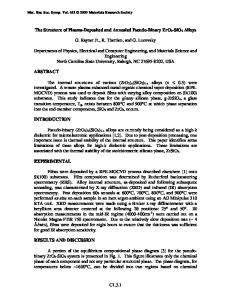The atomic and electron structure of ZrO 2
- PDF / 360,502 Bytes
- 11 Pages / 612 x 792 pts (letter) Page_size
- 95 Downloads / 279 Views
PROPERTIES OF SOLIDS
The Atomic and Electron Structure of ZrO2 A. V. Shaposhnikova, D. V. Gritsenkoa, I. P. Petrenkoa, O. P. Pchelyakova, V. A. Gritsenkoa, S. B. Érenburgb, N. V. Bauskb, A. M. Badalyanb, Yu. V. Shubinb, T. P. Smirnovab, H. Wongc, and C. W. Kimd a
Institute of Semiconductor Physics, Siberian Division, Russian Academy of Sciences, Novosibirsk, 630090 Russia Institute of Inorganic Chemistry, Siberian Division, Russian Academy of Sciences, Novosibirsk, 630090 Russia c Electronic Engineering Department, City University of Hong Kong, Tat Chee Avenue, Hong Kong d Samsung Advanced Institute of Technology, P.O. Box 111, Suwon 440-600, Korea e-mail: [email protected]
b
Received October 18, 2005
Abstract—The atomic structure of amorphous and crystalline zirconium dioxide (ZrO2) films is studied using X-ray diffraction and extended X-ray absorption fine structure techniques. The electron structure of ZrO2 is experimentally determined using X-ray and UV photoelectron spectroscopy, and the electron energy band structure is theoretically calculated using electron density functional method. According to these data, the valence band of ZrO2 consists of three subbands separated by an ionic gap. The upper subband is formed by the O2p states and Zr4d states; the medium subband is formed by the O2s states; and the narrow lower subband is formed predominantly by the Zr4p states. The bandgap width in amorphous ZrO2 , as determined using the electron energy loss spectroscopy data, amounts to 4.7 eV. The electron band structure calculations performed for a cubic ZrO2 phase point to the existence of both light (0.3m0) and heavy (3.5m0) holes, where m0 is the free electron mass. The effective masses of band electrons in ZrO2 fall within (0.6–2.0)m0 . PACS numbers: 71.15.Mb, 71.20.–b, 73.61.Ng, 77.22.–d DOI: 10.1134/S1063776106050128
1. INTRODUCTION In silicon field-effect transistors, a reduction of the channel length to about 600 Å is accompanied by scaling-related decrease in the SiO2 gate insulator thickness down to 12 Å. As a result, the tunneling current through such a thin SiO2 layer increases to an unacceptable level that leads to excess power dissipation. The main approach to solution of this problem consists in replacing SiO2 by so-called alternative insulators with higher values of the dielectric constant, which are also referred to as high-k gate dielectrics [1–3]. Another important application of these high-k materials is related to their use as insulators in capacitors of dynamic random access memories [2, 3]. The third use of alternative dielectrics is in top insulators of Flash memory elements [4, 5]. At present, materials extensively studied as alternative gate dielectrics include hafnium dioxide (HfO2 , ε = 25), zirconium dioxide (ZrO2 , ε = 25), yttrium oxide (Y2O3 , ε = 15), and aluminum oxide (Al2O3 , ε = 10). Among these, one of the most promising is ZrO2 , which possesses a broad bandgap and exhibits high barriers for electron and hole injection at the Si/ZrO2 interface [2, 3]. While the atomic an
Data Loading...










